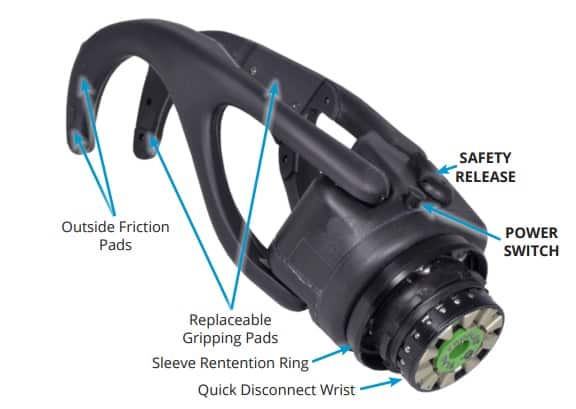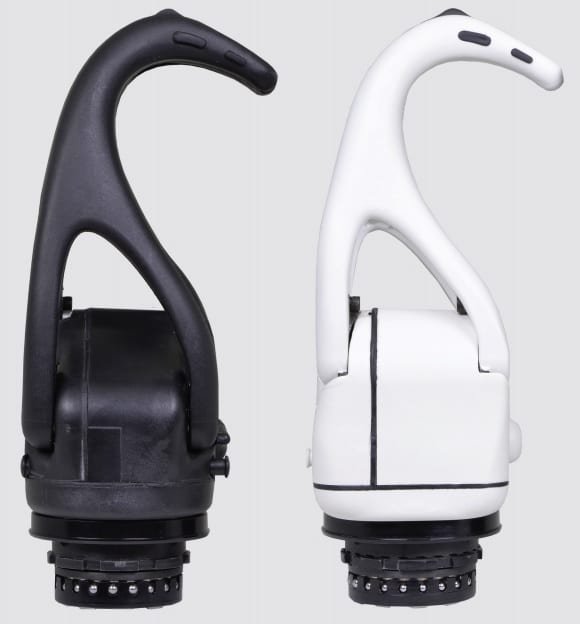The ProPlus MC ETD2 is the next generation of Fillauer’s iconic terminal device, with new innovations to help improve the lives of end-users.
What’s On This Page?
- A Quick Look at the ProPlus MC ETD2
- Changes From the MC ProPlus ETD
- Grip Patterns & Control System
- Proportional Speed Control
- Force-Limiting
- Auto-Grasp
- Sensory Feedback
- Wrist Design
- Lift Capacity & Grip Strength
- Durability
- Water and Dust Resistance
- Glove Options
- Batteries
- User Software
- Suitability for Above-the-Elbow Solutions
- Price
- Warranty
- User Feedback Survey & Results
- Considerations Before Buying a ProPlus MC ETD2
- Related Information
A Quick Look at the ProPlus MC ETD2
Unfortunately, we have not been able to locate good videos of the ETD2 except for this one short clip:
The rest of these videos are for the original MC Standard ETD. We provide them here because they provide excellent examples of the varied tasks that users can perform with an electric hook:
In addition to this basic functionality, the ProPlus MC ETD2 is:
- rugged and durable;
- water resistant (it can be submerged up to the wrist component);
- powerful, with a grip force of up to 107 Newtons; and
- lightweight, coming in at only 454 grams for the standard-length setup.
Changes From the MC ProPlus ETD
The ProPlus MC ETD2 is a direct upgrade to its predecessor, the MC ProPlus ETD.
In case you are familiar with the earlier version, here is what has changed:
- the ETD2 is shorter by a full 3 centimeters;
- it is slightly heavier at 454 versus 425 grams for the standard-length setup;
- it has one less wrist option, i.e. the In-Hand Wrist Rotator is no longer available;
- the heavy-duty hooks now use stainless steel instead of titanium;
- the ETD2 comes with a sleeve retention ring for an optional water-resistant protective sleeve.
The biggest change is the design and construction of the hooks, as you can see in this image:

The hooks are now made of molded plastic with metal inserts for a combination of strength/durability and a sleek design. At the same time, they have been widened to provide a broader surface area to improve holding ability at lower grip strengths (especially important for grasping fragile objects).
Multiple gripping pads have been placed on the inside of the hooks to improve the grip for objects of different sizes and shapes.
Multiple friction pads have been added to the outside of the hooks for improved passive stabilization of objects.
Finally, protrusions have been added to the tops of the hooks to make it easier to do things like press buttons.

In our view, these are all very thoughtful and useful enhancements.
ProPlus MC ETD2 Features
Grip Patterns & Control System
The ProPlus MC ETD2 has only one grip pattern — to open and close one of its hooks (the other hook remains stationary). However, with multiple gripping surfaces located between the hooks and on the outside of them, the device is capable of a wide variety of tasks, including:
- picking up large cylindrical objects;
- grasping handles of tools like shovels or brooms;
- picking up paper from a flat surface;
- pushing buttons such as elevator buttons.
The ETD2 also has several settings that can significantly impact its performance, including:
- the source of control input, i.e. myoelectric versus non-myoelectric (e.g. switch, touchpad, etc.);
- the number of signal channels being used to control the device (single vs dual);
- the methodology used to differentiate between signals;
- signal noise filtering;
- the sensitivity of the device in response to signal strength.
For an in-depth description of these settings, please see the User Software section.
In addition to basic settings, the ETD2 also offers an optional feature set called FLAG (Force Limiting, Auto Grasp). This includes:
- a force-limiting feature to prevent crushing objects due to excessive grip force;
- an auto-grasp feature that automatically increases its grip on an object if the device detects an inadvertent open signal.
Both of these features are described in their own sections below.
Proportional Speed Control
The ProPlus MC ETD2 supports full proportional speed control.
Force-Limiting
This feature works by:
- Reducing the maximum closing speed to a user-defined %. Proportional speed control is still in effect; it is just the maximum speed that is limited.
- When the hooks encounter an object, the amount of force applied to that object will be limited to 9 Newtons. The device notifies the user that this has occurred by producing a short vibration. The user can then incrementally increase the force by repeating the close signal. This can be done to a default maximum of 10 times or 80 Newtons of force, though this maximum setting can be adjusted by the user.
In other words, this feature addresses the default behavior where it is easy to snap the hooks shut too quickly and with too much force, replacing it with a more controlled process, as demonstrated in this short video using the MC ProPlus ETD:
Auto-Grasp
The Auto-Grasp feature for the ProPlus MC ETD2 is not the same as the auto-grasp feature offered by some other bionic devices, where a sensor in one of the “fingertips” detects when an object is slipping and causes the device to automatically increase its grip force. Instead, the ETD2 detects a quick, inadvertent open signal and responds with a single increment of the grip force to prevent the accidental drop of an object. Put another way, this feature merely compensates for an accidental open signal as compared to providing a true auto-grasp feature.
Sensory Feedback
The ProPlus MC ETD2 does not provide any sensory feedback to the end-user other than the short vibration generated as part of the Force-Limiting feature.
Wrist Design
The ProPlus MC ETD2 offers multiple wrist options, including:
- a laminate ring for wrist disarticulation;
- an industry-standard quick-disconnect wrist;
- a flexion wrist with flexion/extension and four locking positions at 52, 26, 0, and -30 degrees;
- a multi-flex wrist that flexes in all directions with locking positions at 30, 0, and -30 degrees of flexion/extension;
- a powered flexion wrist with 153 degrees of powered flexion and two passive resistance settings.
The following video provides a good explanation of the value of some of these options:
Lift Capacity & Grip Strength
The ProPlus MC ETD2 can lift up to 22 kilograms in all directions.
It has a grip strength of 107 Newtons, which is quite high and is comparable to Ottobock’s AxonHook.
Having said that, grip force tends to be measured in different ways by different companies, so comparisons between the grip strengths of competing devices may not be reliable.
Follow Us
Durability
With only one movable hook and a simple, rugged design, the ProPlus MC ETD2 should be considerably more durable than all multi-articulating bionic hands.
Also, the hooks are available in stainless steel for added strength (the standard hooks are made of aluminum).
However, we rely mostly on the results of our User Satisfaction Survey for an objective assessment of durability. And because this article and the associated survey are new, it will likely be a few months before we have sufficient participants to publish results.
Water and Dust Resistance
The ProPlus MC ETD2 has an IPX7 rating, meaning it is water resistant up to but not including its wrist.
The “X” in that rating means that the device has not been certified for dust. There is also no mention of dust or dirt in either the User Guide or the Prosthetist Guide.
We will ask Fillauer about this and update this section when we receive a reply.
Glove Options
There are no glove options for the ProPlus MC ETD2.
Batteries
There is no mention of batteries in any of Fillauer’s documentation for the ProPlus MC ETD2. We suspect that this is because the prosthetist is expected to integrate a battery into the socket to power the device. Alternatively, where an electric elbow is used, the battery power is typically supplied by the elbow unit.
User Software
All Fillauer ETD devices other than the MC Standard ETD and the MC Hand enjoy one of the most comprehensive software applications that we’ve seen for a bionic device’s setup and configuration. The application is used by both prosthetists and end-users — it just disables some of the more advanced functions for end-users. In fact, it is so comprehensive that we’re going to defer the description of it to this lengthy video (31 minutes):
Suitability for Above-the-Elbow Solutions
The ProPlus MC ETD2 can participate in above-the-elbow bionic solutions involving components from many different manufacturers.
Price
We do not currently have good pricing information on the ProPlus MC ETD2. If you have this information, please share it with us through our contact form.
For a complete list of prices for upper-limb ETDs, please see our ETD price list.
Warranty
The ProPlus MC ETD2 offers a 1-year standard warranty against defects in materials or workmanship under normal use.
Note that this is lower than the 2-year warranty offered by Ottobock for its ETD devices.
User Feedback Survey & Results
Survey
Are you currently using a ProPlus MC ETD2 or have you used it in the past?
If so, why not help others by sharing your experiences in this quick survey:
Results
We do not yet have a sufficient number of survey participants to publish fair and accurate results for the ProPlus MC ETD2.
As soon as we do, we’ll update this section.
Considerations Before Buying a ProPlus MC ETD2
In general, we are deeply impressed with Fillauer’s upper-limb ETD options. One immediate consideration for prospective end-users is which ETD to choose. If an end-user is after a device that looks like a hand, then Fillauer’s options are its Motion Control MC Hand and its MC ProPlus Hand, which should both be compared to Ottobock’s SensorHand Speed and VariPlus Speed devices.
If an end-user wants an electric hook, then the ProPlus MC ETD2 or Ottobock’s AxonHook should be their first options, as these two devices represent the latest electric hooks from these two leading prosthetics companies. To be honest, we don’t know if Fillauer is continuing to actively market its earlier-generation electric hooks (i.e. the MC ProPlus ETD and the MC Standard ETD). We cover them because they remain in Fillauer’s online catalog. We will ask Fillauer this question and update this section when we receive a reply.
Beyond these statements, we are reserving judgment on the ProPlus MC ETD2 until we hear back from end-users through our User Satisfaction Survey.
Related Information
For a list of competitor devices, see all upper-limb ETDs.
For a comprehensive description of all current upper-limb technologies, devices, and research, see our complete guide.
Click here for more information on Fillauer’s Upper-Limb Myoelectric Devices.
